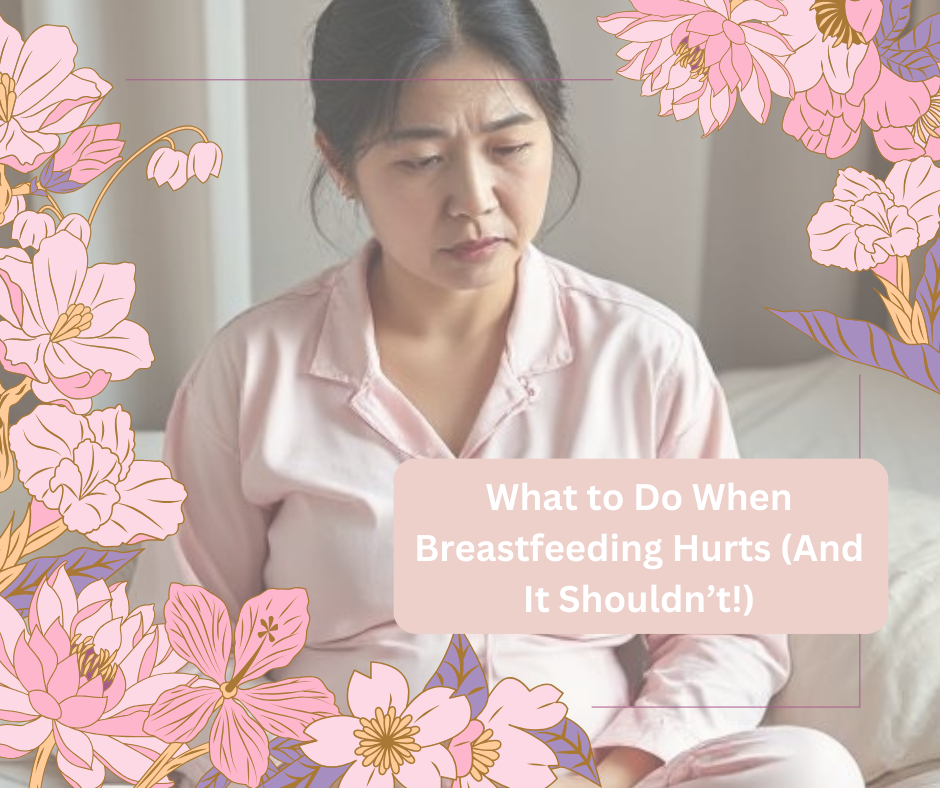
What to Do When Breastfeeding Hurts (And It Shouldn’t!)
Share
I remember sitting in bed, tears stinging my eyes, wincing as I tried to latch my twins for what felt like the hundredth time that day. I had read the books, taken the classes, done everything right — but it still hurt. No one told me how normal it was to feel like you’re doing something wrong when it’s just... painful.
Here’s what I wish someone had told me: breastfeeding isn’t supposed to hurt long-term. Pain is common in those early days, yes — but it’s a sign that something needs adjusting, not something you have to grit your teeth and push through forever.
Whether you're a brand-new mom or a few weeks in and still struggling, this post is for you💗
We’re going to break down:
- Why breastfeeding might be hurting
- How to make it more comfortable (without giving up!)
- And when to reach out for extra help 💬
Because mama, you deserve to breastfeed in comfort — not in pain. Let’s get into it. 🍼
Why Does Breastfeeding Hurt?
Here’s the truth: pain during breastfeeding is common, but it isn’t normal. If it hurts, your body’s waving a little flag asking for support. These are the most frequent causes:
A shallow or poor latch
If your baby isn’t taking enough of the areola into their mouth, it can cause nipple trauma and pain.
Engorgement
Overfull breasts can make latching harder and cause painful pressure.
Nipple cracks, scabs, or bleeding
Especially common in the early weeks as your skin adjusts—but they need TLC, not endurance.
Thrush or infections
Fungal infections like thrush or early mastitis can cause sharp or radiating pain.
How to Relieve Breastfeeding Pain (And Prevent It Next Time)
You're not failing—your body just needs support. Here’s what helped me and thousands of other moms find relief:
1. Recheck Your Baby’s Latch
A good latch is the foundation. Your baby’s mouth should cover the nipple and a good portion of the areola. You should hear soft, rhythmic swallowing—not clicking or lip smacking.
Tip: A lactation consultant can help you get a pain-free latch, often in one short session.
2. Get Comfy (Really Comfy)
If you’re hunched, strained, or holding your breath—your body won’t relax, and pain can worsen. Try a supportive pillow or try side-lying if you’re exhausted.
3. Try New Nursing Positions
The cradle hold isn’t the only option. Try the football hold, laid-back breastfeeding, or side-lying—especially if one position keeps hurting.
4. Moisturize & Protect Sore Nipples
Soothe cracks with lanolin, nipple balms, or your own breast milk. Air-dry your nipples when possible and avoid harsh soaps.
5. Wear a Soft, Supportive Nursing Bra
Tight bras or underwires can block milk flow, worsen soreness, and lead to clogged ducts.
Bloom & Heal’s wire-free maternity bra is buttery soft, breathable, and designed to relieve pressure, especially if you're healing cracked skin or dealing with engorgement.
When to Ask for Help (Without Guilt)
Pain that lingers or worsens isn’t something you need to “tough out.” Here’s when to call your provider or a lactation consultant:
- Severe, stabbing, or burning pain
- Cracked or bleeding nipples that won’t heal
- Sharp pain deep in your breast (could be thrush)
- Fever, chills, or flu-like symptoms (could be mastitis)
- Your baby isn’t gaining weight or seems frustrated at the breast
Asking for help isn’t weakness—it’s wisdom. I wish I’d done it sooner.
Mama, you’re doing something beautiful—but that doesn’t mean it should break you. Pain is a signal, not a sentence. With the right support (and a little bit of softness), breastfeeding can feel better—for both your body and your heart.
💗 Bloom & Heal is here to walk this journey with you. Our wire-free maternity bras are made to ease pressure, support healing, and help you nurse with less pain and more peace.
FAQs: Painful Breastfeeding
1. Is it normal for breastfeeding to hurt at first?
A: Yes, some soreness is common in the first week—but if pain is sharp, lingers beyond 7–10 days, or causes nipple damage, it’s time to get support.
2. How can I tell if my baby has a bad latch?
A: Clicking sounds, shallow sucking, or lipstick-shaped nipples after feeding can signal a poor latch. You may also notice your baby gets frustrated or slides off easily.
3. What’s the best position for less painful breastfeeding?
A: Side-lying or the laid-back/reclined position often help relieve pressure and tension. Football hold can also help if you’re recovering from a C-section.
4. What can I put on cracked nipples to heal them?
A: Try purified lanolin, breast milk, or a nipple balm that’s safe for nursing. Let nipples air-dry and avoid friction from tight bras or pads.
5. Can a tight bra make breastfeeding pain worse?
A: Yes! Tight bras or underwire can compress milk ducts and worsen pain or lead to clogged ducts. A soft, supportive, wire-free bra helps you stay comfortable and supported.
6. When should I see a lactation consultant?
A: Anytime breastfeeding feels too painful, confusing, or emotionally exhausting—don’t wait. Even one visit can make a world of difference.

















































